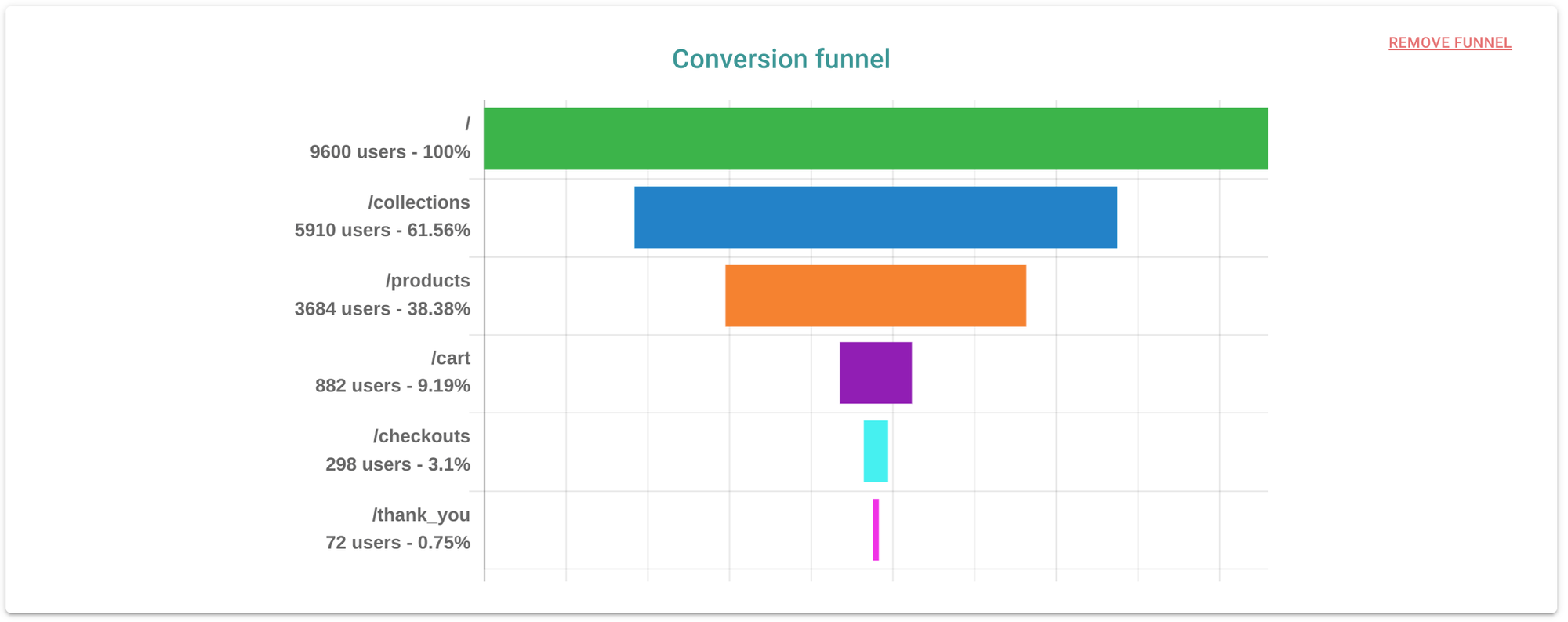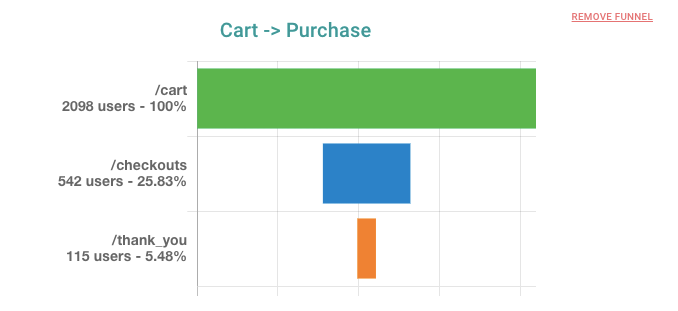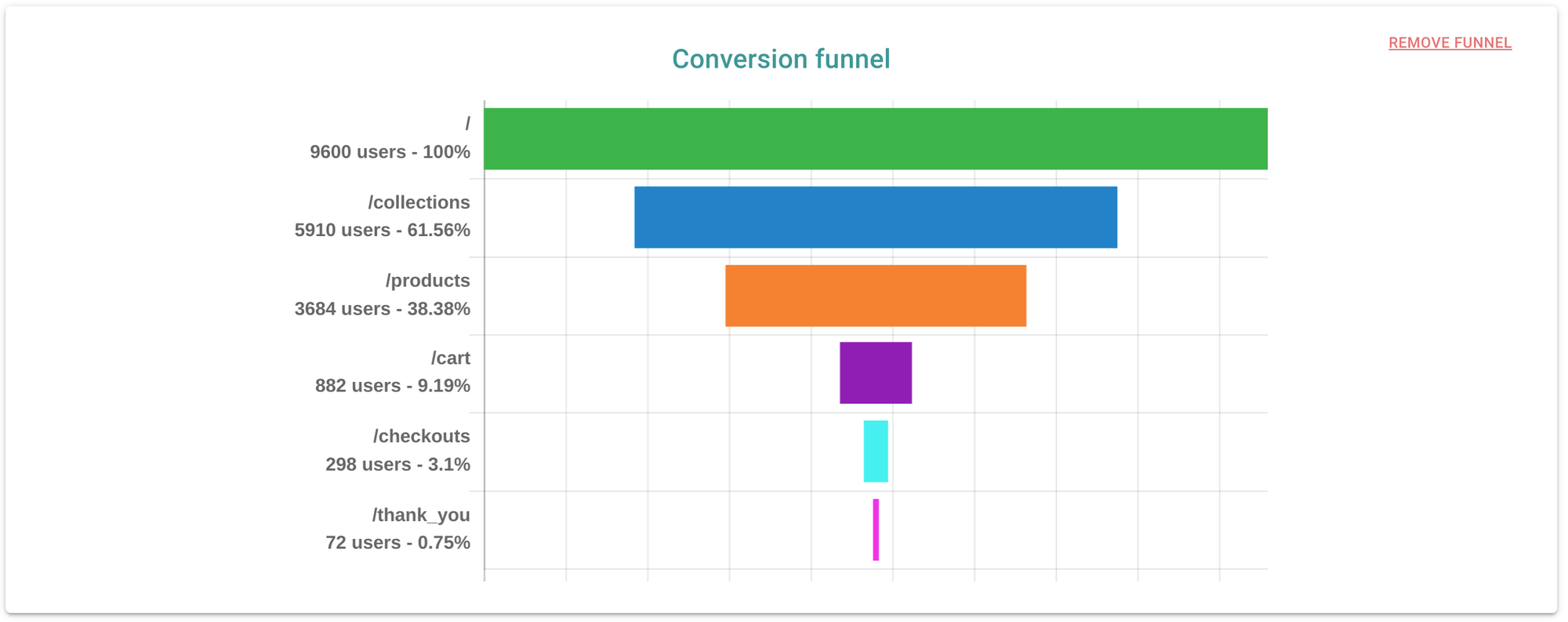Identify the bottlenecks of the conversion route that make you lose visitors
Custom funnels serve you as a tool to identify where you are losing visitors. To use them, imagine step by step the path your users should take to convert and analyze them. The first step will have 100% of visitors, and the funnel lets you see how many of them are getting lost in each of the following steps.
Create any kind of funnel you need to analyze different things. Below we give you some funnel examples, and the reasons why you may be losing customers in each step.
Conversion funnel
This is the most common funnel e-commerce stores use, and serves to see the big picture in a visitor's journey towards conversion.
This is what the funnel looks like:
Home → Category page → Product page → Cart → Checkout → Thank you page

Seeing the steps this clearly makes it easier for you to take action. Here we give you some ideas on what can be causing a customer dropout in each step:
- Category page. If you are losing customers at this step, it most likely means visitors can't find what they were looking for. There can be many reasons: a lack of filters, unclear filters, poor categories, misclassification, counter-intuitive categorization.
- Product page. Again, there can be many reasons here: price higher than expected, poor description, low quality images, insufficient or unclear product specifications, lack of reviews, bad reviews, or maybe you just are out of stock on the size or variable they are looking for.
- Cart. Most likely, there user experience of the cart is bad, and all you need to do is improve the UX of your cart. Everything has to be clear, simple, and as minimal as it can get, so as not to distract users from their goal: to make a purchase. If you are losing a considerable number of customer here, you should make a cart-abandonment mailing campaign, or have customer service contact everyone they can to complete the conversion.
- Checkout. These are visitors who are ready to buy, so this is the step where you should lose less customers. If people are dropping out here, it's quite probable that things are not clear enough in this step, or they were not clear enough in the previous steps. Longer delivery time than expected, hidden charges, shipping prices, lack of multiple payment processors, or extensive forms asking for personal data are all reasons why customers would not complete a purchase. Make sure there are absolutely no surprises in this step, and that there are no distractors diverting people from conversion.
Blog funnel
This funnel helps you realize the impact your blog is having in sales. Depending on what kind of articles you write (product-specific or more general products) these are a couple sample funnel structures:
Blog → Product page → Thank you page
Blog → Home → Thank you page
Remember: here, your objective is to see if you blog impacts sales, so it doesn't matter to you how many people pass through the cart, or checkout. Your goal is only to see if visitors from your blog are interested in buying from you. If the blog is not driving sales, it may be because:
- You are writing for the wrong audience. Try changing a bit the content. Maybe you're writing great informative content, but not necessarily related to sales, nor to you brand.
- There is no link to your brand. Maybe both audience and content are right, but you need to put a link straight to your page, or maybe you just need to insert call to actions in the blog with cues to check out your products, to make it easier for users to buy
This can help you reevaluate the time and importance you are giving to the blog, and adjust them as needed.
Cart funnel
This is a simplified conversion funnel, useful to identify more clearly where you are losing customers in the checkout process. This is the typical structure:
Cart → Checkout → Thank you page

Of course, there are many other funnels you can create: category-related, product related... It's all about which questions you have, and we'll help you answer them.
